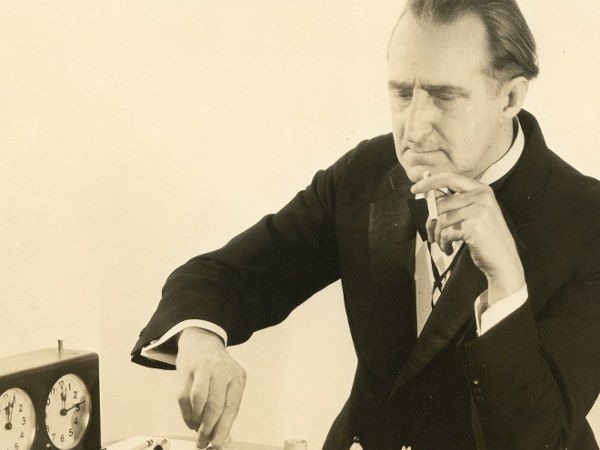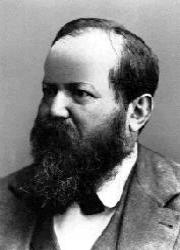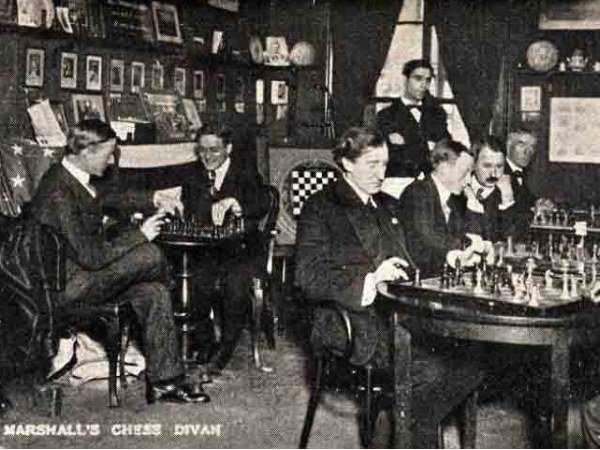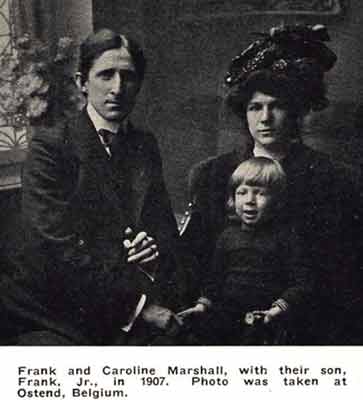


Frank Marshall was born on August 10, 1877, in New York, making today his 140th birthday. When Marshall was eight years old, the family moved to Montreal, Canada. His father was a very good chess player and taught Frank when he was ten years old. The young Marshall showed promise at the game and so he was encouraged to visit the Hope Coffee House, where the best chess players of the city met.
In his autobiography, Marshall's Best Games of Chess he writes, "Stiffer opposition again developed my game and before very long I was able to beat the coffee-house players easily."
 At the age of 13, Frank Marshall was already Montreal's best player, at by age of 15 he won the Montreal Chess Club Championship. In 1893, William Steinitz (pictured at left) visited Montreal and gave a simultaneous presentation, in which Frank Marshall also took part. Although Marshall lost the game in only 26 moves, he was nevertheless praised by the ex-world champion:
At the age of 13, Frank Marshall was already Montreal's best player, at by age of 15 he won the Montreal Chess Club Championship. In 1893, William Steinitz (pictured at left) visited Montreal and gave a simultaneous presentation, in which Frank Marshall also took part. Although Marshall lost the game in only 26 moves, he was nevertheless praised by the ex-world champion:
"I rarely had such a young opponent, which caused me so much trouble."
At 19, Marshall returned to the US and lived in Brooklyn, which was not yet part of New York. He entered the Manhattan Chess Club and the Brooklyn Chess Club and at 22 he won both club championships. The two clubs financed Marshall's trip to the London tournament in 1899. Marshall was not known enough to participate in the A tournament, so he took part in the main tournament and won it. A year later, Marshall played at the famous tournament in Paris, on the edge of the world exhibition at the "Grand Cercle" on Boulevard Montmartre, and finished shared third together with Marozcy behind then World Champion Emmanuel Lasker and Harry Nelson Pillsbury. The win over Lasker by the American, unknown in Europe, was a sensation and Marshall catapulted into the spotlight. Just three years later, Marshall was already strong enough to challenge Lasker for the World Champion's title. However, he could not meet the financial demands of Lasker: 5000 dollars.
 In 1904 Marshall won the US championships but did not accept the title because of the absence of the ailing Pillsbury. (Eventually, he relented in 1909, after winning a match with Jackson W. Showalter, who was champion before Pillsbury. Marshall held the title until 1936. -Ed.)
In 1904 Marshall won the US championships but did not accept the title because of the absence of the ailing Pillsbury. (Eventually, he relented in 1909, after winning a match with Jackson W. Showalter, who was champion before Pillsbury. Marshall held the title until 1936. -Ed.)
At the Cambridge-Springs tournament, also in 1904, he won two points ahead of Lasker and Janowski. 1905 played Marshall competed against two other possible World Champion challengers, David Janowski and Sigbert Tarrasch. While he beat the former 8:4 (with four draws), he was trounced by Tarrasch 1:8 (with eight draws).
However, in 1906, Marshall won the 15th Congress of the German Chess Federation in Nuremberg, ahead of both Tarrash and Janowski.
Since possible competitions for the World Championship against Tarrasch and Maroczy had not come to pass, Lasker, who was living in the United States at the time, eventually accepted the challenge of Marshall and hoped to finance the competition via sponsors in the USA. The match was staged from January to April 1907 as the first to eight wins (draws not count), with games played in New York, Philadelphia, Baltimore, Chicago and Memphis. Marshal failed spectacularly, as Lasker inflicted a devastating defeat, 8-0 (seven draws).
In the lead up to the First World War, Marshall met the dada artist Marcel Duchamp in New York. Duchamp was caught up in chess in New York, dealt extensively with the game, and later even gave up his career as an artist to become a chess professional. Marshall also founded what would become the still-running Marshall Chess Club, in New York.
From Marshall's Best Games of Chess:
One event…took on added importance as the years went on. This was the founding of Marshall’s Chess Divan at Keene’s Chop House, 70 West 36th Street, New York, in 1915. The object was to establish in New York a central meeting place for lovers of chess, much on the same lines as such famous resorts as Simpson’s Divan in London and the Café de la Regence in Paris. It was my idea to make the Divan a place of instruction where young players would be encouraged and where all chess players could feel free to gather.
Duchamp was also a member of the Club.

According to the calculations of the statistician Jeff Sonas, Marshall reached his peak strength in 1913 and was, after Akiba Rubinstein, the second-best player of that time. In the list of the best players in history, Sonas put Marshall at number 29, behind Mikhail Chigorin, in front of Peter Leko.
Frank Marshall was among the players who were surprised by the outbreak of the First World War while at a tournament in Mannheim. In contrast to Russian players like Alexander Alekhine and Efim Bogoljubov, who were detained, Marshall, as a citizen of the initially neutral USA, received 375 German Marks compensation and returned to the United States.
Chess life in Europe largely come to a standstill during and after the First World War. Only in 1925 were the first major tournaments played again. Marshall played in Baden-Baden (shared fifth), Marienbad (shared third) and Moscow (fourth).
In September / November 1929 the US economy was hit by the Wall Street crash. More than half of US stock value was destroyed in one fell swoop. US chess was also hit hard for lack of sponsorship fees. Marshall's Chess Club was in trouble, and forced to relocate, but survived with the help of patrons.
Marshall won the gold medal at the Chess Olympiad in Hamburg in 1930, 1933 in Folkstone, 1935 in Warsaw and 1937 in Stockholm. In Hamburg, he scored an outstanding result at 12½ : 4½. Duchamp, who played for France, was one of the few to force Marshall to yield a draw.
 The Marshall Chess Club was hit hard by the USA's entry into the Second World War. Many members were recruited, including Marshall's son Frank Rice Marshall. In 1942, Raul Capablanca suffered a second stroke at the Marshall Chess Club and died of its consequences on 8 March. Two and a half years later, on November 9, 1944, Frank Marshall was on his way to Jersey City, where he wanted to spend the evening at bingo. In the street, he collapsed of a heart attack. His funeral was held on November 13, 1944. The Marshall Chess Club continued to be run by Marshall's widow Carrie until her death in 1971.
The Marshall Chess Club was hit hard by the USA's entry into the Second World War. Many members were recruited, including Marshall's son Frank Rice Marshall. In 1942, Raul Capablanca suffered a second stroke at the Marshall Chess Club and died of its consequences on 8 March. Two and a half years later, on November 9, 1944, Frank Marshall was on his way to Jersey City, where he wanted to spend the evening at bingo. In the street, he collapsed of a heart attack. His funeral was held on November 13, 1944. The Marshall Chess Club continued to be run by Marshall's widow Carrie until her death in 1971.
Over the course of time, ten books have appeared under Marshall's name. Most of them were written by Fred Reinfeld on the basis of Marshall's handwritten notes in form and paper — "My Fifty Years in Chess" is the most famous.
Frank Marshall used a romantic attack style, with which he could overwhelm many players, but against certain defensive specialists, he struggled. This is also the reason for his high number of losses against Tarrasch and Lasker.
Stepan Levitsky overcame Frank Marshall 1912 in Breslau with an amazing combination:
Marshall was also very creative in opening theory, enriching the opening game with gambits that now bear his name. The Marshall Gambit in the Spanish today plays an essential role in the repertoire of many grandmasters. Other variations in the Queen's Gambit, French Defense and the Sicilian Defense are named after him.
Chess in Russia after the First World War was portrayed in the Russian silent film "Chess Fever" (1925). Frank Marshall appears at the end in a tournament game against Carlos Torre:
Until the end, Marshall enjoyed the game of chess. He put it this way:
"I've been playing it for over 50 years, I started it when I was ten, and I am still going strong. In all that time I don't believe a day has gone by that I have not played at least one game of chess — and I still enjoy it as much as ever."
Translation from German: Macauley Peterson